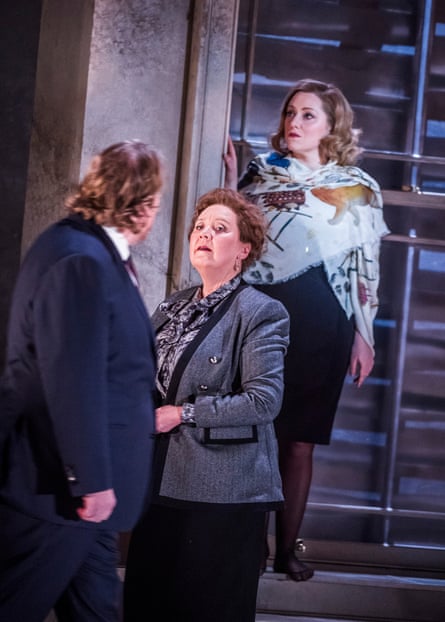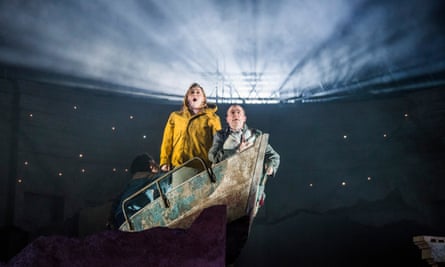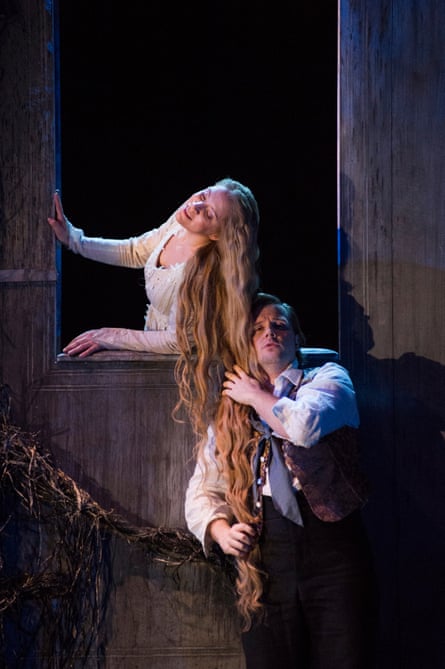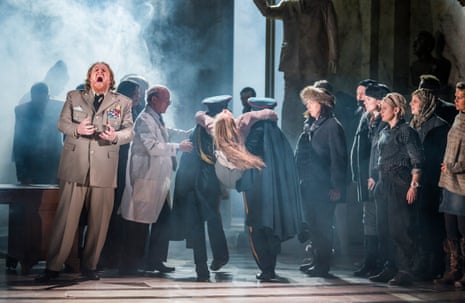Paddling palms and pinching fingers… I’ll have thy beauty scratch’d with briers… When you do dance, I wish you a wave o’ the sea… The Winter’s Tale has so much music of its own, refined in the fire of Shakespeare’s strange late play, it is hard to think an operatic version could add more. Surely it would shrink instead of grow. Instead, Ryan Wigglesworth (b1979) has made a thoughtful and lyrical case, not smaller or bigger but different, in his first opera, commissioned by English National Opera and premiered at the Coliseum last Monday.
He also wrote the libretto and conducted the performance. No mad egoist – really not, though as it happens he is also a virtuoso pianist – Wigglesworth left the designing to Vicki Mortimer and, as a wild shot, invited the actor Rory Kinnear to make his debut as a stage director. In a clever set whose two halves split and reunite, the action has been updated to contrasting military regimes, two versions of fragile power. Leontes’s Sicilia is all medals and peaked caps, Polixenes’s Bohemia khaki, shades and black berets: you’ll have seen them before at the opera if not in life. ENO has gathered a wonderful cast of British singers. Led by Iain Paterson (Leontes), Leigh Melrose (Polixenes), Susan Bickley (Paulina) and Sophie Bevan (Hermione), who is also the work’s dedicatee, they honoured this new score.
So far so good. Many an operatic axe has fallen on Shakespeare’s plays, Macbeth, Hamlet, The Tempest, A Midsummer Night’s Dream, Romeo and Juliet among them. The better the composer, broadly but no guarantee, the more convincing the result. We have grown used to unexpected happy endings, mashed-up plots or radical reinventions (think Bernstein’s West Side Story). We may even forget that Shakespeare was the source.
A first encounter with a new interpretation is another matter. Abandoning the play can involve a tough wrestle for the audience. High horses to the ready, we list the changes and ask how a composer dare weld his or her more modest skills to the greatest writer in the English language. We want proof of purpose. The idea of homage is somehow not allowable. Thomas Adès met that response when his 2004 opera, The Tempest, was new.

Inevitably similar questions arise with The Winter’s Tale. Wigglesworth fell for the play as a student some two decades ago. That affinity shows. His short text is never drowned out by the orchestra. Quintessential phrases, such as those quoted at the start of this column, remain intact. Every word is audible. Action is simplified, plot meanders excised, which leaves some key moments feeling peremptory. Heralded by the chiming bells that start each act, the opera plunges in without preamble. Almost immediately, Leontes, a despot bestriding his own marble hall of heroic statues – including one of himself – succumbs to jealousy, believing his wife has been unfaithful. We move quickly to catastrophe and Hermione’s “death”, with the rural frolics of Bohemia providing a spry scherzo to the darkness of the outer acts.
Wigglesworth’s score is fluid and sensuous, building on the tradition of Britten and Tippett but with plenty of individuality – the pairing of piano and harp, the dry, whip-crack intimations of tension, the anger of the Apollo chorus. Textures are shaded not spattered. Wigglesworth prefers restraint to explosive drama. The music converses rather than shouts, it unfolds in harmonic argument rather than noisy headlines, though the composer is quite capable of a triple fortissimo when needed. Is this enough for opera? Some will think not. We’ll discover as the work settles. I was absorbed throughout, but not quite ambushed. I’m not sure The Winter’s Tale, an ever enigmatic play, invites that kind of response.

Kinnear’s staging did not distract, though a couple of clumsy moments need sorting out. Paterson’s Leontes fills the stage, his folly and arrogance palpable and chilling, his remorse touching. Melrose is agile and strong as Polixenes. As Hermione, Sophie Bevan conjured the role’s dignity and anguish impeccably, with an unearthly top B utterance as she, a statue, returns to life and cries out to the gods. Susan Bickley’s sage and authoritative Paulina deserves a prize. The impetuous young lovers Florizel and Perdita (Samantha Price and Anthony Gregory), Neal Davies as Antigonus and Timothy Robinson as Camillo all excelled. Go and decide for yourself.
The bad blood of violence and abusive desire runs deep through Debussy’s Pelléas et Mélisande, based on Maeterlinck’s symbolist play. The composer imagined that his orchestra was a forest and that his tragic heroine could die among the violins. This is not quite the case in David McVicar’s new staging for Scottish Opera – brilliantly designed by Rae Smith with lighting by Paule Constable – the company’s first Pelléas since 1979. Every aspect, though, is exemplary, starting with the conductor Stuart Stratford, Scottish Opera’s music director, who draws terrific playing from the orchestra, urgent, pulsating and menacing. The floor-level pit in Glasgow’s Theatre Royal added to the impact.

Using the Danish artist Hammershøi as a touchstone, Rae’s designs merge forest and castle, interior and outside as one. Blind windows fill one side of the stage, tall, dark pine trunks the other. The ever present, ever watchful family sit around a table, midway between the two. All looks beautiful, and claustrophobic. Carolyn Sampson’s Mélisande had scorching purity, mysterious to the end. “La vérité!” she cries on her death bed, but what is the truth of this woman whom we first encounter weeping? Sampson’s experience as a baroque singer reaped rewards here. The baritone Andrei Bondarenko was a compelling Pelléas despite his Ukrainian accent never yielding to French vowels. Roland Wood’s Golaud, no monster until suspicion reduces him to despair, evoked terrible pity. Alastair Miles as the old king, Arkel, plays out the confusions of incomprehension, horror, cowardice and helplessness with heart and voice. Cedric Amamoo (b2003) gave an intelligent and remarkable performance as the boy Yniold. When Golaud held him up to the window to spy on the illicit adults Pelléas and Mélisande, the tension was intolerable: enough to make you grip the chair arm. For a moment this 1902 opera felt like Hitchcock.
Star ratings (out of 5)
The Winter’s Tale ★★★★
Pelléas et Mélisande ★★★★★
The Winter’s Tale is in rep at the Coliseum, London until 14 March

Comments (…)
Sign in or create your Guardian account to join the discussion